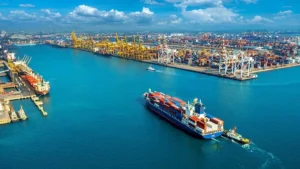Vikram Singh Meena shares how drones are transforming logistics through advanced technology, addressing challenges in last-mile delivery, and fostering sustainability through innovation, collaboration, and cutting-edge solutions that shape the future of logistics.

Drones are revolutionising logistics, driving the sector’s technological transformation forward
The logistics sector is undergoing a technological revolution, and at the heart of this transformation are drones. Once limited to niche applications, drones are now evolving into indispensable tools for overcoming logistical challenges, particularly in last-mile delivery and remote-area supply chains. Vikram Singh Meena, Founder and CEO, TechEagle Innovations, sheds light on how drone technology is reshaping the logistics landscape.
Advancements in drone technology
Modern drones are no longer just flying devices; they are marvels of engineering and innovation. Hybrid eVTOL (electric Vertical Take-Off and Landing) designs now allow drones to achieve longer ranges and higher speeds, ensuring rapid deliveries over vast distances. For instance, precision landing systems and 5G-enabled communication facilitate autonomous operations in challenging terrains, reducing manpower dependency and ensuring timely deliveries.
These advancements have yielded tangible benefits: operational costs have been cut by up to 40%, customer satisfaction has improved due to reliability, and delivery times have been slashed dramatically. Drones have become indispensable for healthcare, e-commerce, and emergency deliveries, especially in regions lacking infrastructure.
Tackling last-mile and remote logistics
Last-mile delivery has always been fraught with challenges such as traffic congestion and high costs. In remote areas, poor road connectivity often compounds the issue. Drones provide a direct and efficient solution by bypassing these barriers entirely.
Take, for example, disaster relief efforts during a natural calamity in Meghalaya. Blocked roads made it impossible to deliver life-saving medicines to isolated villages. Drones flew the supplies in under 30 minutes—a feat that would have taken hours by conventional means. Such operations highlight the capability of drones to bridge logistical gaps, transforming them from operational tools to lifesaving assets.
Seamless integration
Integrating drones into logistics frameworks requires a combination of technology, regulation, and operational alignment. Ground control systems that centralise flight planning, delivery tracking, and fleet management are pivotal. AI-powered route optimisation further ensures faster and more efficient deliveries.
However, Meena emphasises the importance of regulatory collaboration. Permissions such as Beyond Visual Line of Sight (BVLOS) approvals are crucial for scaling drone operations. By working closely with regulators, logistics providers can align technology and compliance, creating scalable solutions for diverse scenarios.
Towards a sustainable future
The collaboration between drone manufacturers, logistics providers, and regulators is key to fostering a sustainable logistics ecosystem. Manufacturers must prioritise efficiency and durability, while logistics companies need to streamline drone integration. Regulatory bodies can facilitate innovation through supportive policies and infrastructure development.
By reducing carbon footprints, cutting costs, and enabling faster adoption, drones are paving the way for a greener, more efficient future in logistics. With continued innovation and collaboration, this technology holds the potential to redefine supply chains, making them more resilient and sustainable.











